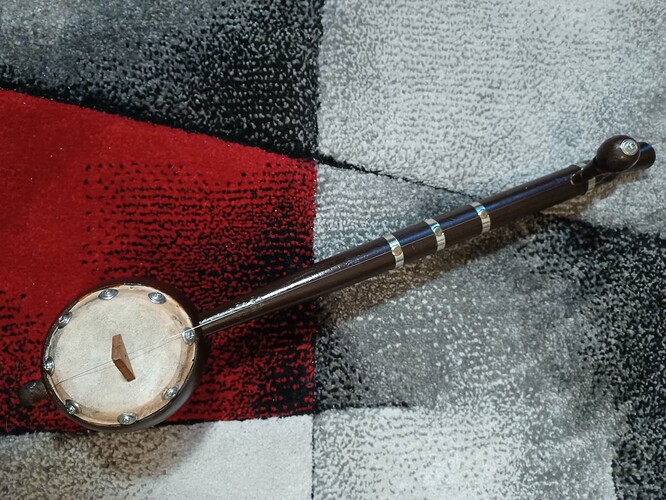I find @cleary's approach on how to create a sample set for TidalCycles very useful (fbass rocks!). Currently there is a discussion about a sample pack format, however I thought until then we could use this thread to share sample sets created by community members.
Based on the fbass sample set approach I tried to create a sample set based on my ukulele: GitHub - thgrund/samples-ukulele: Ortega lizard ukulele samples - tuned to C with various attacks styles, releases, vibrato, slides and harmonics
I normalized it to -1.0 dBFS and recorded it as dry as possible at 60 bpm with various variations.
Since I recorded without compression, the samples are usually only half as long as with fbass. But this had not caused me any problems so far. So if you want to try it out, feel free to leave a feedback.
And last but not least, I recorded a little performance using the samples. In the code the samples are called sally, because I named my ukulele that way.
They sound killer, almost have a harp quality to them.
Thanks for making - and also for the github layout, I'm planning to build a little repo of git submodules with a bunch of sets I like. This is going in 
Actually one thing I didn't mention through the course of my working on a creation method - string instruments are notoriously approximate with their tunings. I tuned my string so that the fretted note was bang on the C rather than tuning to the open string (which would have made my fretted c approximate only). Did you encounter this too?
Glad to hear you like them!
I am excited what ideas you will still realize in this field.
Most stringed instruments I have are relatively stable in terms of tuning on the different frets. But to be on the safe side, I did the same as you. In addition, you also have to be careful between the tone of the attack, the sounding tone and the release (it also depends on the playing style). Did you also sit there and experiment with various strokes? 
Yeah absolutely, I had a list of the variations scribbled in front of me, then would have 10 or so strokes/plucks per individual style. Then played each group of 10 back and picked a winning one. I went round this process quite few times tbh... It was... Very much a learning experience ![]()
Cloned and added to my samples bank! I'll let you know what I do with them!
Maybe if I have the time I'll try to make clarinet and saxophone samples soonish.
I am very interested to see how you will use the samples!
And more instrument samples using the cleary method would be really nice. Someday we'll have a whole TidalCycles orchestra together 
By the way, besides vibrato I also sampled slides (no. 09 and 10). I had been playing around with them but am pretty undecided if you can do anything useful with them.
Hey! I have a set of acoustic drum samples taken from a recording session I did with my "heavy sludge/noise" band, simple kit, kick, snare, tom, floor, hihat, crash and ride.
I'd like to share them with the community, I would like to know how to "standardize" them: length, peak, precision etc... any advice welcome!
Would be great to include them into the new GitHub - tidalcycles/Clean-Samples: Like Dirt-Samples, but cleaned up repository
I think the standards are really only just starting to be developed. I've been normalising mine to -1.0db peak, but that may be a little high for drum samples. I know @yaxu has been normalising to a -3.0db peak - it's probably worth doing them at -3 or -2 and giving them a try, see how they mix in?
For length, I tried some standardised lengths for my short release bass samples, but it just didn't sound very ... natural, so I just did manual muting on the short releases, and left them at whatever length they came out.
I think if you do go down that path, maybe try and work in whole second increments, so you can back calculate easily. With cps 0.5 (60bpm @ 4/4),
1s == 1 quarter note
4s == 1 cycle/4 quarter notes
etc
precision I haven't looked at, if that means sample rate, I think mine have been 48000kHz but not for any reason than it was a default.
What I will note, @geikha was looking at standardised naming for percussion sets - he ran a poll iirc, may have some input on what to do there
I reactivate this thread once because I have created a new sample pack which I optimized for TidalCycles. The samplepack is made with a Tumbi - tuned to C with different attack styles, releases and harmonics.
Tumbi is a so called "Ektara" type of instrument which means "one stringed".
You can find the samples here: GitHub - thgrund/samples-tumbi: Tumbi samples - tuned to C with various attack styles, releases and harmonics
Here you can find a little showcase of those samples I created:
You can find the Tidal code of this showcase here: samples-tumbi/showcase.tidal at master · thgrund/samples-tumbi · GitHub
Maybe one or the other would like to try them out ![]()
I have recorded them with a microphone, so I hope that I caa able to minimize the noise as good as possible.

